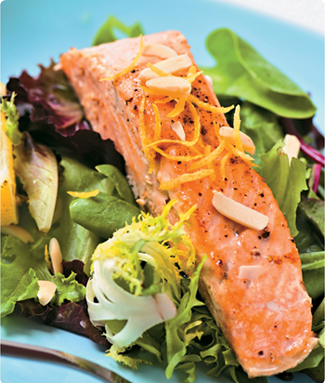 13) will work wonders for your appearance, a few skin superstars are worth working into your diet for their anti-aging benefits.
13) will work wonders for your appearance, a few skin superstars are worth working into your diet for their anti-aging benefits.Skin is the body’s largest living organ, and it needs top-notch nourishment to function and look its best. While a healthy diet filled with fruits and vegetables, whole grains, lean protein, and good fats ( 13) will work wonders for your appearance, a few skin superstars are worth working into your diet for their anti-aging benefits.
13) will work wonders for your appearance, a few skin superstars are worth working into your diet for their anti-aging benefits.
You’ve probably heard about the benefits of omega-3s for heart health ( 58) and the brain (
58) and the brain ( 25). But mounting research shows that they, along with omega-6s, are also critical for skin health and can fight signs of aging. These essential fatty acids calm inflammation and irritation caused by free radicals. They keep cell membranes fluid and flexible and normalize oil production by creating protective lipids (fatty substances) in your skin’s topmost layer—especially helpful as your skin gets drier with age, and since dry skin makes wrinkles more noticeable (
25). But mounting research shows that they, along with omega-6s, are also critical for skin health and can fight signs of aging. These essential fatty acids calm inflammation and irritation caused by free radicals. They keep cell membranes fluid and flexible and normalize oil production by creating protective lipids (fatty substances) in your skin’s topmost layer—especially helpful as your skin gets drier with age, and since dry skin makes wrinkles more noticeable ( 1). Omega-3s and omega-6s also defend against cell damage and assist in repair, keeping skin resilient. A 2006 review of studies concluded that consuming omega-3s can actually protect skin from sun damage as well.
1). Omega-3s and omega-6s also defend against cell damage and assist in repair, keeping skin resilient. A 2006 review of studies concluded that consuming omega-3s can actually protect skin from sun damage as well.
Omega-3s and omega-6s are called essential fatty acids because our bodies can’t make them, so we have to get them through diet. Omega-6s are abundant in foods like eggs, vegetable oils, poultry, and grains, and most people consume more than enough. The trick is getting enough omega-3s. Omega-3s are a group of several nutrients, including eicosapentaenoic acid (EPA) and docosahexaenoic acid (DHA). Fatty, cold-water fish like wild salmon, lake trout, albacore tuna, herring, anchovies, and sardines are among the best sources. Surprisingly, grass-fed beef also offers a respectable amount. Omega-3-fortified eggs and other fortified foods are another option. Walnuts, ground flaxseed, and soy foods like tofu provide another omega-3 known as alpha-linolenic acid (ALA), which the body can use to make EPA and DHA. Broccoli, cabbage, and other leafy greens also supply small amounts of ALA.
Like omega-3s and omega-6s, antioxidant vitamins A, C, and E fight free radicals that can damage skin and lead to wrinkles and even skin cancer. Topical antioxidants get a lot of press ( 7), but your primary goal should be to get enough through diet. Brightly colored fruits and vegetables, such as avocados, broccoli, carrots, kiwis, nuts and seeds, oranges, red and green peppers, spinach, and strawberries are super sources. It can be tough to get enough vitamin E from foods, but you should talk to your doctor if you’re thinking about supplementing, since vitamin E can act as a blood thinner, and high levels may interfere with cholesterol-lowering drugs. If you choose to supplement with vitamin E, take 400 IU of mixed natural tocopherols daily (d-alpha tocopherol is the natural form; avoid synthetic dl-alpha tocopherol).
7), but your primary goal should be to get enough through diet. Brightly colored fruits and vegetables, such as avocados, broccoli, carrots, kiwis, nuts and seeds, oranges, red and green peppers, spinach, and strawberries are super sources. It can be tough to get enough vitamin E from foods, but you should talk to your doctor if you’re thinking about supplementing, since vitamin E can act as a blood thinner, and high levels may interfere with cholesterol-lowering drugs. If you choose to supplement with vitamin E, take 400 IU of mixed natural tocopherols daily (d-alpha tocopherol is the natural form; avoid synthetic dl-alpha tocopherol).

A 2009 study noted that people with high levels of selenium in their blood reduced their risk of skin cancer by about 60 percent. Its antioxidant action helps prevent premature skin aging, and it encourages vitamin E absorption as well. Good sources include brown rice, seafood, garlic, eggs, and Brazil nuts.
Another multitasker, zinc, protects your skin from sun damage and works with vitamin C to make collagen. A zinc deficiency can trigger breakouts, lead to hair loss, and cause rough skin or rashes. Food sources include oysters, legumes (such as beans and peas), red meat, pecans, and pumpkin seeds. If you don’t eat many animal foods, you might want to supplement, but the National Institutes of Health Office of Dietary Supplements recommends getting no more than 40 milligrams per day.